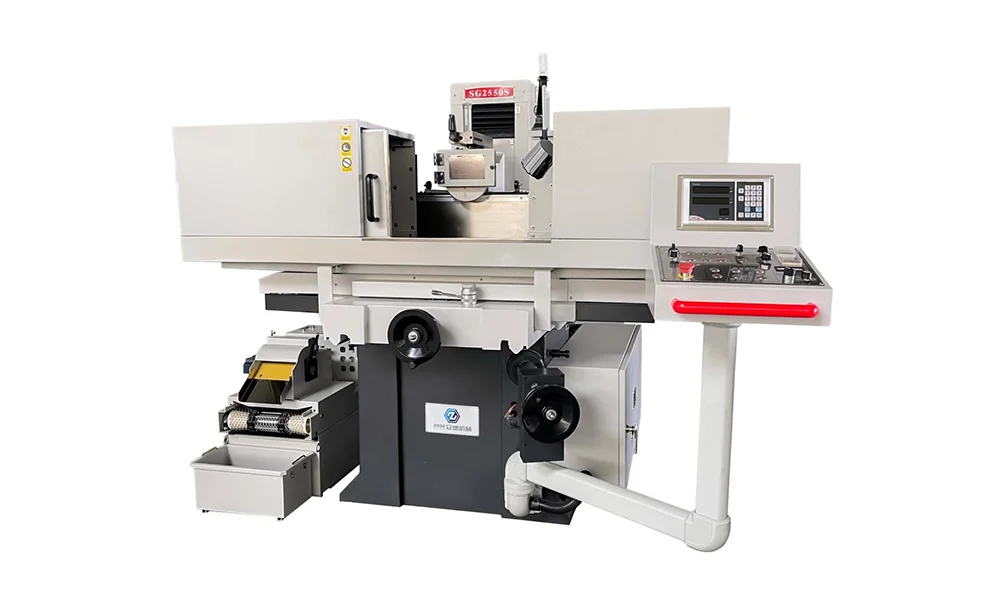Introduction to Single Axis PLC Grinding Machine
In the modern manufacturing landscape, precision and automation are at the heart of competitive success. A single axis PLC grinding machine embodies this trend, integrating programmable logic controller (PLC) technology with grinding equipment to deliver repeatable accuracy and simplified operation. By combining automation with mechanical reliability, this type of machine supports industries that demand both efficiency and consistent surface quality. In this blog post, Nantong Zode, a high performance automatic CNC surface grinder manufacturer, will share the advantages of single axis PLC grinding machine for sale, its applications, etc.
Role of PLC in Single Axis Grinding System
At the core of a PLC-based single axis grinding machine lies its ability to control motion and process parameters with minimal human intervention. The programmable logic controller acts as the “brain” of the system, automating repetitive movements along a single axis while monitoring parameters such as feed rate, speed, and grinding depth. This functionality reduces errors, ensures higher process consistency, and provides operators with intuitive control interfaces.
Advantages of Single Axis PLC Grinding Technology
Adopting a single axis programmable grinding machine offers a wide range of operational advantages:
-
Simplified Operation: The PLC interface reduces the learning curve for operators, making setup and adjustments more straightforward.
-
Enhanced Repeatability: Single axis automation ensures uniform grinding cycles, which is vital for mass production tasks.
-
Reduced Human Error: Automated controls minimize manual intervention, improving safety and reducing defects.
-
Process Monitoring: PLC systems often include diagnostic tools that alert operators to performance deviations.
These benefits make the equipment ideal for industries such as automotive, aerospace, and tool manufacturing, where precision is non-negotiable.

Applications of Single Axis PLC Grinding Machine
The versatility of a single axis automated grinding system extends across multiple industrial sectors:
-
Automotive Components: Producing shafts, bearings, and engine parts that require exact surface finishes.
-
Aerospace Engineering: Grinding turbine blades or critical components that demand high precision.
-
Tool and Die Manufacturing: Creating reliable molds and dies with consistent grinding quality.
-
Metal Fabrication: Ensuring accurate finishing on structural parts and custom components.
By focusing on these areas, the machine bridges the gap between traditional manual grinding and fully automated multi-axis solutions.
Single Axis PLC Grinding Machine vs. Multi-Axis Systems
While multi-axis machines offer broader functionality, a single axis PLC grinding machine remains attractive due to its cost-effectiveness and simplicity. Multi-axis systems are often complex, requiring significant investment and specialized training. In contrast, single axis models provide a streamlined solution for manufacturers that prioritize one-dimensional precision grinding. This makes them especially suitable for small to mid-sized enterprises.
Technological Innovations in PLC Grinding Machines
Recent innovations have elevated the role of single axis PLC-controlled grinding machines:
-
Smart Sensors: Integrated feedback systems allow real-time monitoring of tool wear and part quality.
-
Data Connectivity: Modern machines can connect to factory networks, enabling predictive maintenance and performance tracking.
-
Energy Efficiency: Optimized PLC programming reduces idle times, lowering power consumption.
-
User-Friendly HMIs: Graphical touchscreens make programming grinding cycles intuitive and accessible.
These features illustrate how the machine is not just a tool but part of a larger digital manufacturing ecosystem.
Future Trends of Single Axis PLC Grinding Systems
As Industry 4.0 adoption grows, the role of the single axis PLC grinder will evolve. Anticipated trends include integration with cloud-based monitoring platforms, adaptive control algorithms for self-optimizing grinding, and compatibility with robotic loading systems. For small and medium-sized manufacturers, these advancements will make high-precision machining more accessible and affordable.
Why Choose Single Axis PLC Grinding Machine for Your Business?
Selecting a PLC-driven single axis grinding solution is not only about cost savings; it also positions a business for future competitiveness. These machines strike a balance between affordability and high-quality output, ensuring that even small-scale production facilities can meet global standards of precision and efficiency.
Conclusion
The single axis PLC grinding machine represents a powerful synthesis of automation and simplicity. By focusing on one axis of precision and leveraging PLC technology, it meets the growing demand for reliable, efficient, and adaptable grinding processes. Whether applied in automotive, aerospace, or tool manufacturing, this equipment provides a pathway to enhanced productivity and consistent product quality. As innovation continues, the single axis system will remain a cornerstone of accessible precision machining.
www.zodemc.com
Nantong Zode